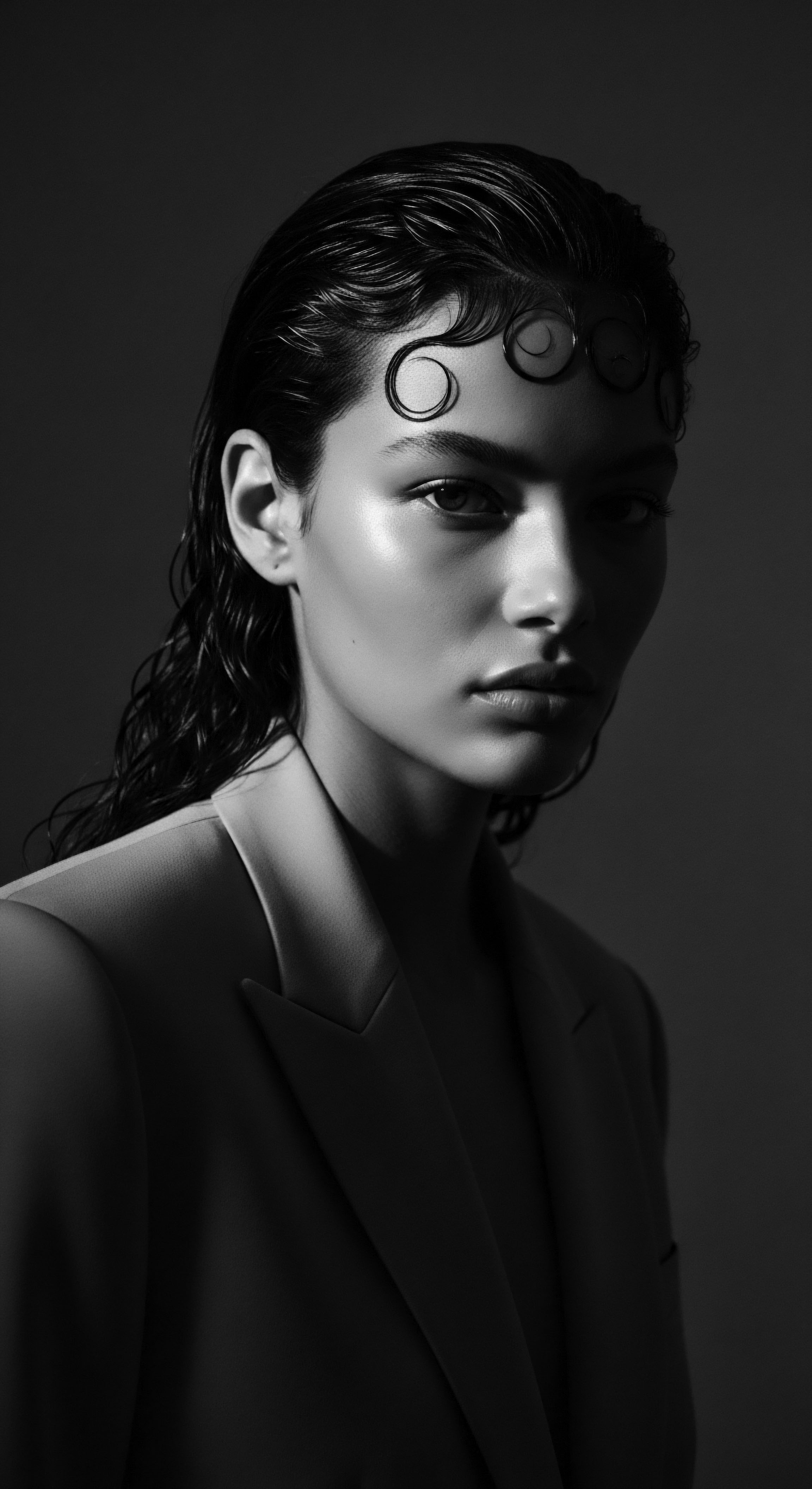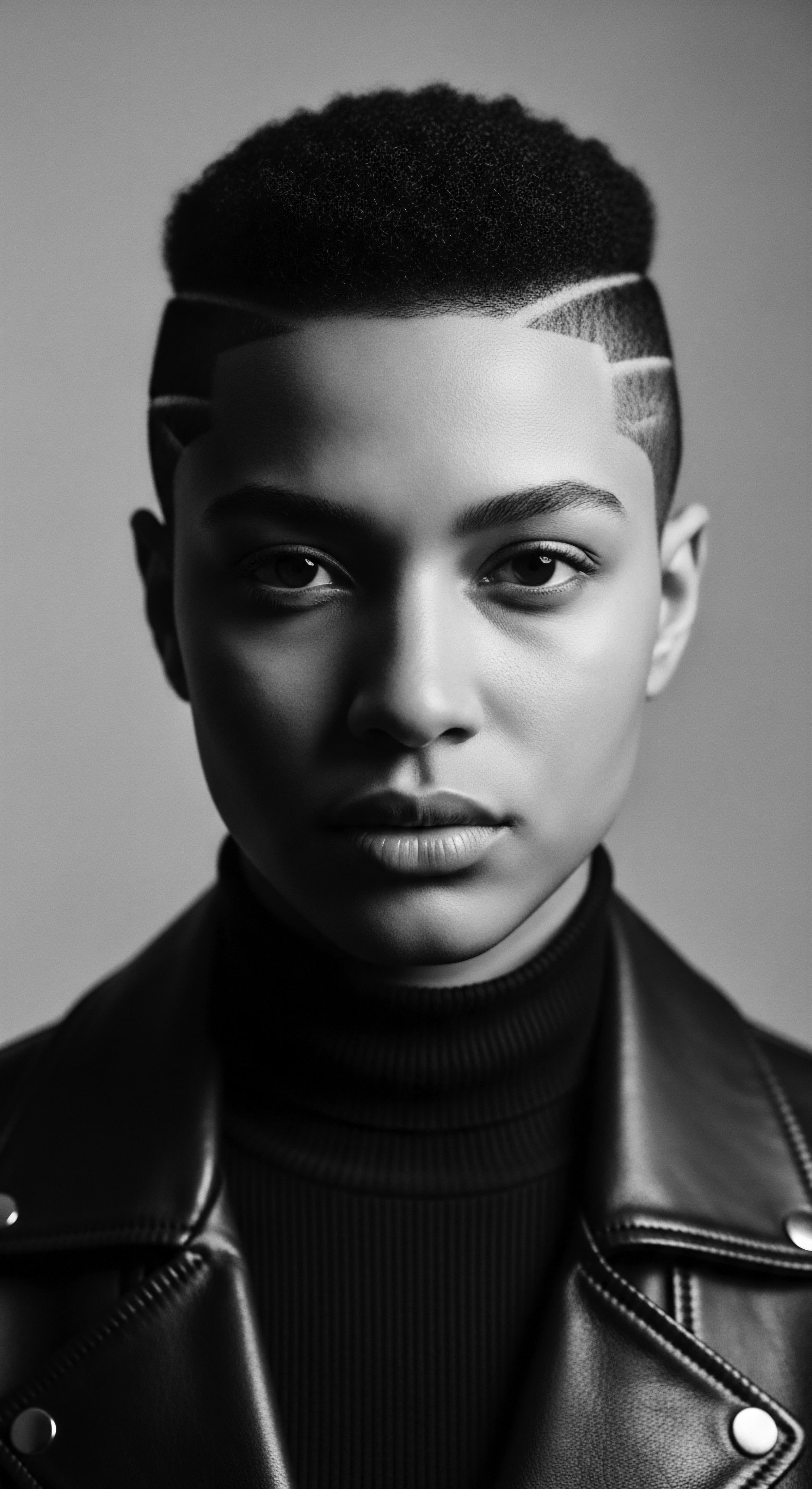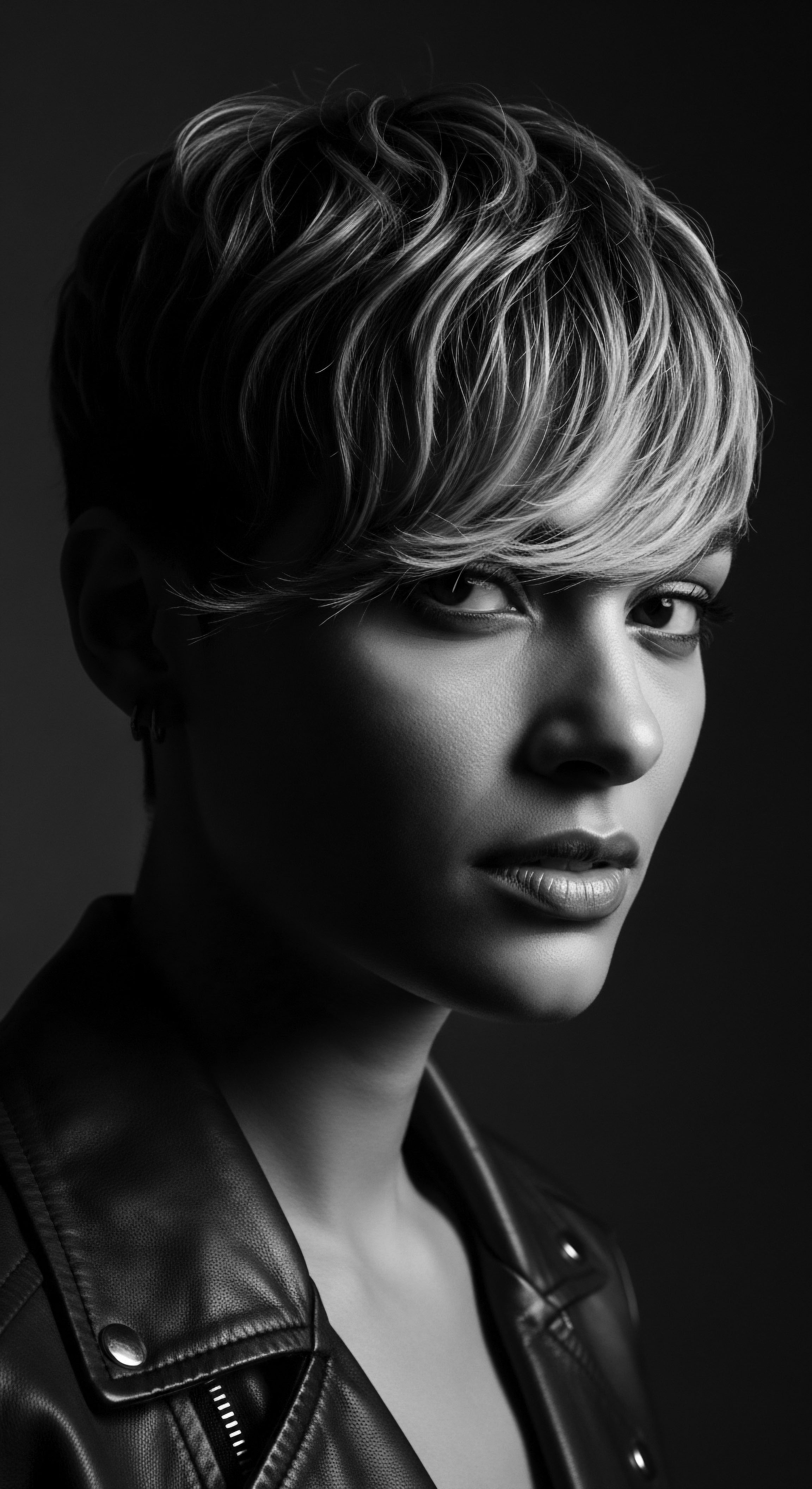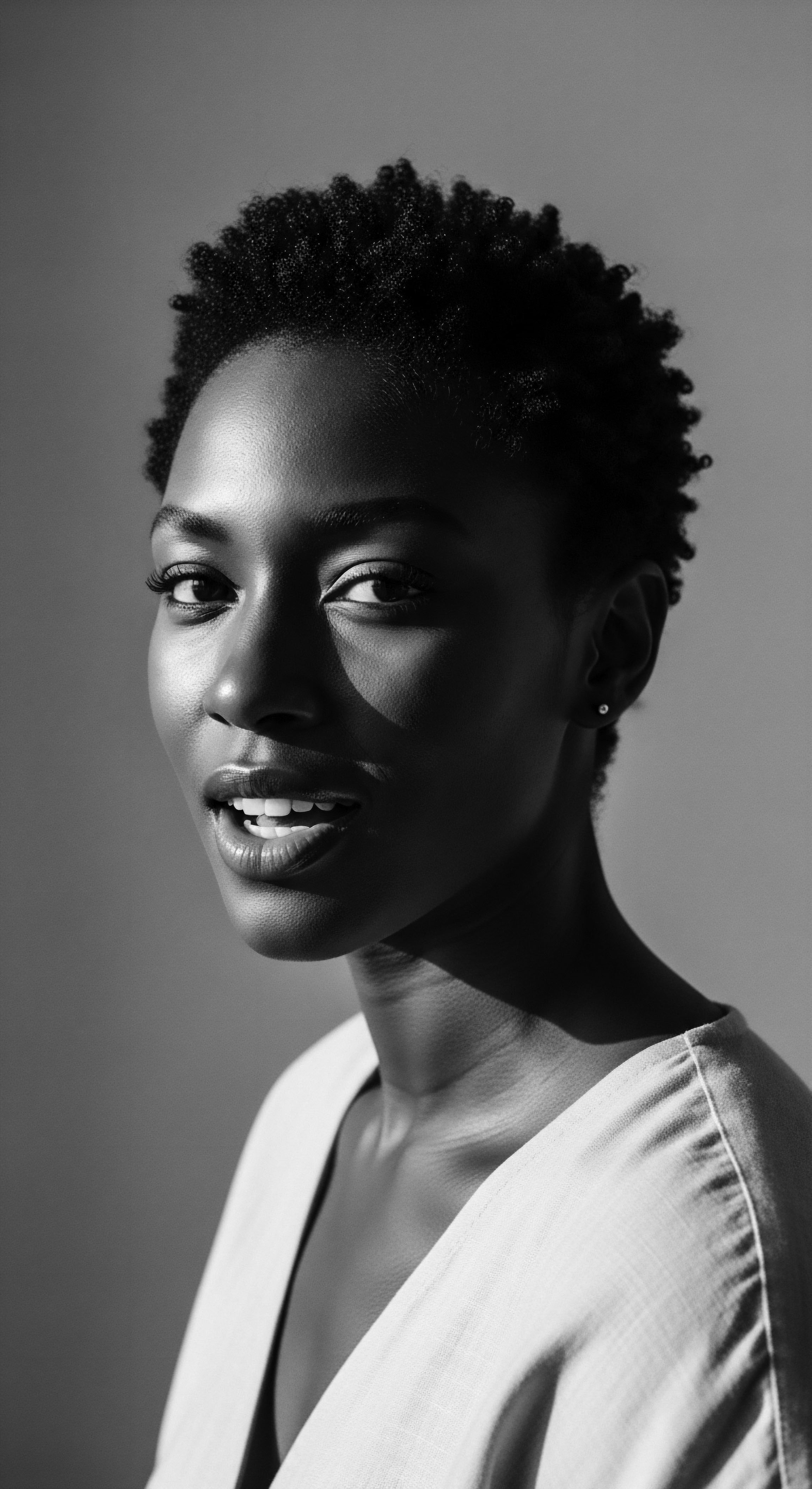
Fundamentals
The study of Ancient Roman Hair, viewed through the delicate yet resilient lens of Roothea, extends beyond mere historical cataloging of styles and practices. It offers an invitation into the profound narrative of adornment, identity, and the very fibers that graced heads in a civilization so pivotal to Western thought. At its most elemental, Ancient Roman Hair represents the confluence of natural biology and societal aspirations, where the intrinsic qualities of individual strands met the prevailing aesthetic demands of an empire. This exploration is not simply an archaeological endeavor; rather, it becomes a soulful excavation, seeking connections to the enduring heritage of textured hair, the profound experiences of Black and mixed-race individuals, and the echoes of ancestral practices that resonate across time.
Understanding Ancient Roman Hair requires a look at its fundamental components. The hair itself, an outgrowth of keratinized protein, responded to the environment, nutrition, and inherited genetic predispositions, much as it does today. Yet, the Roman perception and manipulation of this biological gift were deeply imbued with social meaning. Hair served as a visible testament to one’s social standing, marital status, age, and even philosophical leanings.
The simplicity or complexity of a style, the choice of adornment, and the very texture of the hair—whether natural or artfully enhanced—communicated volumes within Roman society. This fundamental interpretation of Ancient Roman Hair reveals a core truth ❉ hair has always been a language, a silent yet potent form of communication that speaks of self and community.
Ancient Roman Hair, when viewed through Roothea’s perspective, reveals itself as a silent language of identity and belonging, intricately woven from biological realities and societal aspirations.
For those delving into this historical period, the basic elements of Roman hair care involved a variety of tools and substances. Combs fashioned from wood, bone, or ivory, curling irons heated over embers, pins crafted from precious metals or simpler materials, and nets woven with fine threads were commonplace. Beyond these implements, the Romans employed a fascinating array of ingredients for cleansing, conditioning, and coloring. Olive oil, often infused with aromatic herbs, served as a fundamental conditioner and styling agent.
Plant-based dyes, such as henna or saffron, were used to alter hue, while harsher substances, including lye and various ashes, were sometimes applied to achieve lighter shades. These ancient methods, while seemingly distant, hold a profound significance when considered against the backdrop of traditional hair care practices in other cultures, particularly those with deep ancestral wisdom surrounding natural ingredients and holistic well-being. The initial steps into understanding Ancient Roman Hair provide us with a groundwork, a basic vocabulary, for appreciating its deeper historical and cultural resonance.

Early Interpretations of Hair’s Role
The Romans inherited many of their aesthetic and grooming practices from earlier civilizations, notably the Greeks and Etruscans. Early Roman hairstyles were often quite modest, reflecting a society that valued practicality and sobriety. Men typically wore their hair short, sometimes even shaved, a style associated with military discipline and civic virtue. Women’s hair, though generally more elaborate than men’s, maintained a certain simplicity.
The early emphasis was on neatness and restraint, a deliberate contrast to the perceived excesses of their Eastern neighbors. This early Roman approach to hair management reflects a desire for order and control, a mindset that would later adapt and shift dramatically as the empire expanded and encountered a kaleidoscope of cultures and aesthetic ideals. The hair, even in its most unadorned state, conveyed a public statement about personal and civic values.

Bridging Ancient Practices to Modern Understanding
Considering these fundamentals, we begin to see how the very definition of Ancient Roman Hair extends beyond historical description. It becomes an invitation to connect with enduring questions about hair and identity that continue to shape experiences within textured hair communities today. The use of natural oils, the manipulation of texture through heat, and the social symbolism attached to hair are all echoes that resonate across millennia.
The tools and techniques of Rome, rudimentary as they might seem, represent humanity’s persistent desire to adorn, protect, and express through hair. This foundational understanding lays the groundwork for a more intricate exploration of how the Roman hair experience, particularly its engagements with diverse textures, offers vital insights for our contemporary journey of hair wellness and cultural appreciation.

Intermediate
Moving beyond the foundational description, an intermediate comprehension of Ancient Roman Hair delves into the complexities of its evolving meaning and the societal forces that shaped its representation. The meaning of hair in Roman society shifted dramatically from the Republic to the Empire, transitioning from a symbol of republican modesty to an extravagant display of wealth and status. This transformation reflects broader changes within Roman culture, including increased prosperity, exposure to diverse aesthetic influences from conquered lands, and a growing emphasis on public image and personal presentation.
Hair, in this context, became a dynamic canvas, a living testament to an individual’s place within a hierarchical and rapidly changing social order. The significance of these evolving styles is multifaceted, touching upon economics, politics, and the intimate daily lives of citizens.
The transition from simple, practical styles to elaborate coiffures, especially for women during the Imperial period, is a powerful indicator of this shift. Intricate braids, towering structures of curls, and voluminous rolls of hair adorned the heads of elite Roman women, each style requiring considerable skill and time. These often involved the extensive use of assistants, or ornatrices, many of whom were enslaved and possessed specialized knowledge in styling and dyeing.
The investment in hair care was not merely personal vanity; it was a societal imperative, a visual marker of one’s affluence and social standing. This level of dedication to hair presentation speaks to a deeply ingrained cultural value, where external appearance was inextricably linked to internal worth and public perception.

The Craft of Roman Hair Design
The intricate styling observed in Roman portraiture was achieved through a combination of natural hair manipulation and the clever integration of artificial elements. Curling irons, known as calamistra, were instruments of profound transformation, heated to reshape straight hair into tight spirals or soft waves. Hairpins, often jeweled or crafted from precious metals, secured complex arrangements. Nets, ribbons, and diadems served as additional adornments.
A particularly significant aspect of Roman hair artistry was the widespread use of wigs (galeri) and hairpieces (tituli). These were not simply fashion accessories; they provided a means to augment volume, create desired textures, or even conceal hair loss. The sources for these artificial hair components were varied, often coming from enslaved individuals or the hair of deceased family members, highlighting a complex interplay of personal identity, societal power dynamics, and the commodification of hair itself.
This phenomenon, where hair was sourced and manipulated, resonates with certain aspects of textured hair heritage. The practice of altering one’s natural hair to conform to prevailing beauty standards, or to express identity through hair manipulation, is a historical constant across diverse cultures. In Rome, while the dominant aesthetic often favored particular types of curls or straightened looks, the very act of acquiring and integrating hair from various origins speaks to a society engaging with, and at times appropriating, diverse hair qualities. The meaning here extends beyond mere aesthetics; it touches upon the economic realities of hair as a commodity and the social implications of its origins.
Roman hair artistry, through intricate styling and the extensive use of wigs, mirrors humanity’s persistent engagement with hair as a malleable medium for identity and social expression.
The preservation of specific hairstyles through art and sculpture allows us a window into these practices. The statues of empresses like Julia Domna, with her strikingly voluminous, highly structured coiffure, or Faustina the Younger, with her elaborate braided coronet, provide tangible evidence of the extraordinary lengths to which Roman women went to sculpt their appearance. These iconic representations become more than just artistic renditions; they stand as historical documents, offering insights into the hair ideals of the time and the skilled labor involved in their creation.

Hair Dyes and Their Social Significance
Beyond styling, hair coloring also played a significant role. Blonde and red hair, often associated with Germanic or Gallic peoples, became highly fashionable, particularly among elite Roman women, during certain periods of the Empire. This pursuit of altered hair color sometimes involved harsh substances, including strong lye solutions derived from plant ashes, which could significantly damage the hair shaft.
This historical practice of chemically altering hair for aesthetic or social reasons finds parallels in the ongoing conversations within textured hair communities about the impact of chemical processes on hair health and integrity, particularly when conforming to Eurocentric beauty standards. The quest for a particular hue was deeply intertwined with social aspirations and the desire to mimic the “other” who had become admired, or even objectified, within the Roman social imagination.
- Oils and Unguents ❉ Olive oil, often blended with fragrant botanicals, served as a foundational element for both cleansing and styling, a practice echoed in many ancestral hair traditions across the globe.
- Hairpins and Fasteners ❉ Ranging from simple bone implements to ornate gold or silver pieces, these tools were essential for securing complex braids and towering coiffures, demonstrating a long-standing appreciation for functional hair accessories.
- Dyeing Agents ❉ While plant-based dyes like henna offered natural color shifts, more caustic substances were employed to achieve striking blondes or reds, revealing an enduring human desire to dramatically alter hair’s intrinsic properties.
The intermediate understanding of Ancient Roman Hair, then, transcends a mere description of styles. It allows for a deeper appreciation of the societal pressures, technological ingenuity, and the human desire for self-expression that defined Roman hair practices. These historical insights, when viewed through the compassionate lens of Roothea, become valuable touchstones for understanding the broader human relationship with hair, its adaptability, and its persistent connection to identity across diverse cultural contexts and experiences.

Academic
The academic definition of Ancient Roman Hair, as conceptualized within Roothea’s framework, transcends a simple chronological description of styles or tools, instead positing it as a complex socio-cultural construct. This construct served as a dynamic semiotic system, encoding and transmitting intricate messages about status, identity, gender, and even political affiliation within the highly stratified Roman societal fabric. It represents a living archive of human interaction with the pilus, a testament to both biological reality and the boundless capacity for artistic, social, and ideological manipulation of the self.
From an academic vantage, Ancient Roman Hair becomes a rigorous field of inquiry, requiring interdisciplinary approaches that weave together archaeology, art history, classical philology, and emerging perspectives from critical race studies and material culture. The meaning of Ancient Roman Hair, through this lens, is thus less about what it was and more about what it signified, how it functioned, and what its profound implications remain for our understanding of identity construction, particularly for those whose hair textures have historically been marginalized or subjected to external pressures.
Scholarly inquiry into Roman hair necessitates an examination of its material reality—the keratin itself, the tools used to manipulate it, and the organic and inorganic compounds applied for care and coloring—alongside its abstract symbolic dimensions. The persistent visual evidence from statuary, frescoes, and mosaics provides invaluable primary data, yet this artistic representation must be critically analyzed, acknowledging its idealized or propagandistic nature. For instance, the meticulously sculpted coiffures of imperial women were not merely fashionable; they often represented a carefully curated public image, reflecting virtues like modesty, fecundity, or imperial power.
The subtle variations in these styles, understood by contemporary observers, acted as visual cues, shaping public perception and legitimizing authority. The academic pursuit of Ancient Roman Hair, therefore, is an exercise in deconstructing these layers of meaning, revealing the profound interplay between aesthetic ideals and lived experience within a highly hierarchical society.

The Commodification of Hair and Its Connection to Textured Hair Heritage
One particularly potent area of academic exploration, deeply resonant with the heritage focus of Roothea, involves the commodification and sourcing of hair for Roman wigs and hairpieces. While Roman writers like Martial and Ovid frequently celebrated the use of hair from Germanic or Gallic captives for wigs, implying a preference for lighter, often straighter hair, the broader reality of the vast and diverse Roman Empire suggests a more complex dynamic. Hair, much like other resources, was bought, traded, and sometimes forcibly taken from various regions. This raises critical questions about the invisible labor and embodied experience behind these elaborate Roman coiffures.
The intricate sourcing of hair for Roman wigs, including from diverse populations, reveals a historical precedent for hair’s commodification and its complex entanglement with power dynamics and identity.
Consider the presence of individuals of African descent within the Roman Empire, whether as enslaved persons, merchants, or soldiers. Their hair, with its inherent coil and curl patterns, presented a different textural landscape than the often-preferred straight or wavy European hair. While direct, explicit documentation on the specific treatment or utilization of African hair within the Roman wig industry is sparse in surviving texts, its existence within the empire’s diverse population makes it a subject ripe for nuanced interpretation. Scholars have argued that the Roman penchant for wigs and hairpieces could have allowed for a degree of stylistic conformity regardless of natural hair texture, effectively masking or altering natural hair types to fit prevailing aesthetic norms.
This historical practice echoes the challenges faced by Black and mixed-race individuals across centuries, where natural textured hair has often been pressured into conformity with Eurocentric beauty standards through straightening, chemical treatments, or the use of wigs and weaves. The academic analysis here suggests that the Roman engagement with hair manipulation was not merely a matter of fashion but also an exercise in cultural control and the assimilation of diverse somatic traits into a dominant aesthetic.
An important specific historical example, often overlooked in mainstream accounts, involves the material sources of Roman hair. While often idealized in literature as blonde spoils of war, archaeological and textual evidence points to a far broader range. Indeed, the very nature of Roman expansion and conquest meant that their societal practices, including those of hair styling, would inevitably encounter and sometimes absorb, or appropriate, diverse cultural elements. The presence of hair and hair products from Egypt and North Africa within Roman trade networks, documented through archaeological finds, strongly implies the availability of hair of various textures.
This commercial exchange of hair, while not directly detailing its styling on specific textured hair types, underscores the fact that the Roman hair industry was interacting with, and drawing upon, the hair of diverse populations. The scholarly work of Kelly Olson, in her extensive study “Hair in the Roman World ❉ A Social and Cultural History,” highlights the economic dimensions of hair procurement, where hair was a valuable commodity, traded and transformed to meet elite demand. Olson (2017, p. 77) notes that “hair was bought and sold, often from the heads of captives or the poor, to satisfy the fashion for elaborate coiffures and wigs among the elite.” This general statement, while not singling out African hair, provides the foundation for inferring that hair from all available sources, including those from diverse ethnic backgrounds within the empire, would have entered this market. The meaning of Ancient Roman Hair in this context thus expands to encompass a dynamic system of global exchange and aesthetic appropriation.
The deeper meaning of Ancient Roman Hair, therefore, is deeply rooted in the interplay between control and expression. Hair could be a badge of honor for the citizen, a symbol of mourning for the bereaved, or a statement of rebellion for those who defied imperial norms. For enslaved individuals, their hair, much like their bodies, was often not their own. Its styling might have been dictated by their owners, or perhaps, in quiet acts of resistance, they maintained traditional styles when possible.
This nuanced understanding requires a sensitivity to power differentials and the often-unwritten narratives of marginalized populations. It prompts us to consider not just the glamorous portrayals in statuary, but the daily reality of hair care across the vast spectrum of Roman society, including the complex, unrecorded experiences of those with textured hair.

Analyzing Roman Hair Products and Their Ancestral Parallels
A detailed academic examination of Roman hair products reveals a striking parallel with ancestral hair care practices found across various cultures, particularly within Black and mixed-race traditions. While the Romans did not have the scientific understanding of emollients, humectants, or protein treatments that modern trichology offers, their practical application of natural ingredients often yielded results that align with contemporary wellness principles.
| Roman Practice/Ingredient Olive Oil as Conditioner ❉ Applied extensively to hair for shine and manageability. |
| Traditional/Modern Textured Hair Parallel Natural Oils (e.g. Shea, Coconut, Jojoba) ❉ Used in textured hair for moisture, scalp health, and styling. |
| Significance for Heritage Highlights the enduring wisdom of natural ingredients for hair health across millennia, connecting ancestral knowledge. |
| Roman Practice/Ingredient Use of Plant-based Dyes ❉ Henna, saffron, and other botanical extracts for coloring. |
| Traditional/Modern Textured Hair Parallel Herbal Hair Colorants ❉ Resurgence of plant-based dyes in natural hair communities for gentle color and conditioning. |
| Significance for Heritage Shows a continuous appreciation for earth-derived solutions for hair adornment, honoring traditional approaches. |
| Roman Practice/Ingredient Hair Perfuming (Nardinum, etc.) ❉ Aromatic oils to scent hair and ward off unpleasant odors. |
| Traditional/Modern Textured Hair Parallel Scented Hair Mists/Oils ❉ Used for refreshing and adding subtle fragrance to hair and scalp, often with beneficial herbs. |
| Significance for Heritage Demonstrates the holistic connection between scent, personal hygiene, and sensory well-being as a part of hair care rituals. |
| Roman Practice/Ingredient Calamistra (Curling Irons) ❉ Heated metal rods used to create tight curls and waves. |
| Traditional/Modern Textured Hair Parallel Heat Styling Tools (e.g. Curling Wands, Flat Irons) ❉ Used for texture manipulation, though with modern advancements for reduced damage. |
| Significance for Heritage Underlines the universal human desire for texture alteration, and the historical continuity of tools designed to achieve specific aesthetic outcomes, sometimes at hair's expense. |
| Roman Practice/Ingredient These parallels reveal a timeless human engagement with hair, where ancient ingenuity and natural resources paved the way for practices still relevant in the care of textured hair today. |
The academic definition of Ancient Roman Hair, then, extends to a thoughtful analysis of its legacy. It invites us to consider how the dynamics of beauty, status, and control, so evident in Roman hair practices, have reverberated through history, impacting diverse communities and contributing to the very discourse of hair in contemporary society. The significance of this study is not merely historical; it offers profound clarity on the enduring power of hair as a cultural artifact, a personal statement, and a deeply resonant connection to ancestral wisdom and experiences.
- The Vestal Virgins’ Hair ❉ Their distinctive six-braided hairstyle, worn throughout their sacred 30-year service, symbolized chastity, purity, and unwavering devotion to the goddess Vesta, a powerful marker of their unique spiritual and social status within Roman society.
- Mourning Hair Practices ❉ During periods of grief, Roman women would often wear their hair loose and disheveled, sometimes cutting it short as a visible sign of sorrow, a powerful non-verbal communication of profound personal loss.
- Bride’s Hair ❉ A Roman bride’s hair was traditionally parted with a spear-shaped iron (hasta caelibaris) and styled into six braids, then often bound with wool fillets, symbolizing fertility and the binding nature of the marital union.
The academic exploration of Ancient Roman Hair becomes a journey into the enduring complexities of human identity and expression, particularly when viewed through the lens of hair’s ancestral journey. It offers a unique framework for understanding how the practices of an ancient empire continue to inform, challenge, and connect with the contemporary experiences of textured hair communities worldwide. The meaning of Ancient Roman Hair, therefore, is a testament to the enduring human desire to define, adorn, and express oneself through the very strands that grow from our heads, echoing themes of status, self-definition, and cultural exchange across the breadth of human history.

Reflection on the Heritage of Ancient Roman Hair
In drawing our exploration of Ancient Roman Hair to a close, Roothea invites us to pause and consider the enduring legacy that echoes from these ancient practices. It is a legacy not confined to the annals of classical history but one that reverberates through the very fabric of our understanding of hair, its care, and its profound connection to identity, particularly for those whose lineage carries the rich heritage of textured hair. The journey through Roman coiffures, their tools, and their societal implications reveals an unbroken thread of human ingenuity, desire for expression, and the often-complex interplay between personal choice and communal expectation regarding hair.
The significance of Ancient Roman Hair, viewed from this heritage-focused perspective, lies in its capacity to serve as a mirror. We see reflected within its historical contours universal human experiences ❉ the quest for beauty, the display of status, the nuanced art of self-presentation, and the impact of cultural exchange on aesthetic ideals. For individuals with Black and mixed-race hair, this reflection holds a particularly poignant truth.
The historical manipulation of hair in Rome, whether for aesthetic preference or social conformity, finds compelling parallels in the historical journey of textured hair through eras of assimilation, resistance, and reclamation. The very act of styling, adorning, or altering hair, then as now, is deeply personal and political.
The story of Ancient Roman Hair reminds us that hair, at its core, is a profound expression of heritage. It carries not only our biological blueprint but also the accumulated wisdom, challenges, and triumphs of generations past. The Roman emphasis on hair as a public statement, while distinct in its specific manifestations, speaks to a fundamental human truth ❉ our hair tells a story. This story is one of resilience, adaptability, and the enduring spirit of self-definition.
As we look back at the elaborate structures and simple cuts of Rome, we can appreciate the ingenuity that flowed from their hands, and perhaps, more importantly, recognize the deep kinship of human experience that transcends time and geography. The care we extend to our hair today, often informed by ancestral practices and modern understanding, is a continuation of this ancient, deeply personal ritual, honoring the tender thread that binds us to our past and guides us into our future.

References
- Olson, K. (2017). Hair in the Roman World ❉ A Social and Cultural History. University of Wisconsin Press.
- Bartman, E. (1999). Ancient Sculptural Copies in Miniature. Brill.
- Dasen, V. (2018). The Routledge Handbook of Greek and Roman Dress and Adornment. Routledge.
- Martial. (1968). Epigrams. Translated by W. C. A. Ker. Harvard University Press.
- Ovid. (1979). Ars Amatoria. Translated by J. B. Hall. Duckworth.
- Sebesta, J. L. & Bonfante, L. (Eds.). (2001). The World of Roman Costume. University of Wisconsin Press.
- Fantham, E. (2006). Ovid’s Metamorphoses. Oxford University Press.
- Nisbet, G. (2006). Greek and Roman Hair. In A. J. S. Spawforth, & E. J. Kennedy (Eds.), The Oxford Companion to Classical Civilization. Oxford University Press.
